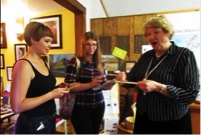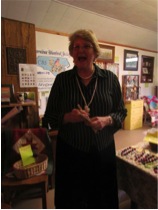By Rachel Fishman – 2014
After being told by a Brasstown local that we could see a gorgeous panorama of the town from the hill above the shop-lined main street on Highway 64, we could not resist. As we turned up Emily Lane and drove the short, but steep incline to the top, we realized that we were on someone’s personal property. Parking our car in what seemed to be a small parking lot, we got out and looked around to see if we were truly in the outlook spot promised to us by the townsperson. Before we had much time to figure anything out, we were greeted by Carol–a spunky, sweet-voiced, middle-aged Southern woman.
Carol is the owner of Hill Gallery & Working Studios, the place that we had apparently stumbled upon. After learning that we were visitors, she eagerly invited us onto the porch to explain a bit of Brasstown history before launching into her family’s role in the town. Because of the deeply rooted Appalachian culture, she explained that there are some unique items that can be found in the mountains, especially toys. Taking us inside, Carol gave us a rundown of some of the most famous toys of Appalachia, including the Whimmy Diddle—a toy which her husband is a worldwide champion for playing.
A Whimmy Diddle is a ribbed stick that you rub together with a smooth one to produce a sound along the lines of “Gee-Haw.” This Appalachian toy has been used by the Hill Gallery & Working Studios owners for competitions and personal entertainment, in addition to being sold in their store. It has been the focus of many different types of benefit competitions that they put on for various charities last October, November, and December. Carol excitedly explained that the winner of these competitions gets a moon pie, an RC Cola, and a certificate of participation.
To play the Whimmy Diddle, it requires that you to hold the top stick with one hand like a pencil, with your thumb on one side of the top stick and your pointer finger on the top. The other hand holds the bottom stick in place. You then must drop your pointer finger slightly to the opposite side while letting your thumb hit the stationary bottom stick, rubbing it back and forth across the stick to produce the intended sound. Katie tried it out, making slight alterations to her hand placement per Carol’s suggestions until she got a sound that more closely resembled the one coming from Carol’s sticks. Much to our excitement, we even got a special demonstration from the Whimmy Diddle champion himself, a man to which Carol endearingly referred to as “my mountain man.”
The difficulty of achieving the right sound far surpassed what would have been expected. Carol explained, “You know, it’s just like riding a bike or anything. You just have to practice, and it becomes a piece of cake.” However, after learning that it is created using a mathematical formula and a consideration of not only the type but also the condition of wood that is used, the “simplicity” of the toy was quickly wiped away.
The reason for promoting the Whimmy Diddle and the other types of Appalachian toys in their store represents a desire to keep the Appalachian culture alive. Carol explains that they are trying to teach children that they don’t need a computer or other forms of technology to have fun—the expertise of the Appalachian toy creators makes simple toys largely entertaining.


